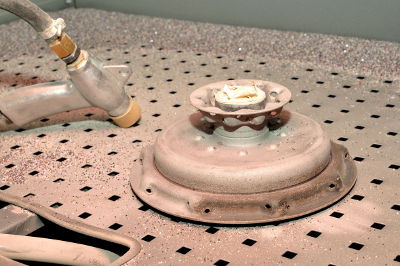Surface pre-treatment
 In terms of adhesion technology there are requirements on the surfaces to be bonded to ensure successful bonding. This is because even the "greatest and best" adhesive can only carry out its task if it can set up sufficient adhesion. To do this, the service may need to be specially pre-treated which would include two important steps:
In terms of adhesion technology there are requirements on the surfaces to be bonded to ensure successful bonding. This is because even the "greatest and best" adhesive can only carry out its task if it can set up sufficient adhesion. To do this, the service may need to be specially pre-treated which would include two important steps:- Preparation
- Pre-treatment
The aim of treating the material surface is to end up with a surface suitable for the bonding task. Adhesion-based preconditions for a surface are:
- firmly bonded to the base body
- easily whetted
- sufficient surface area for the bonding
- no uncontrolled changes after bonding
1. Preparation of the surface
This includes cleaning and de-greasing, which can be considered the minimum requirement for most bonding processes. Even after pre-treating the surface, e.g. by abrading or sandblasting, the surface has to be cleaned again after this so that the melt adhesive actually bonds to the adherent and not to the loose particles.2. Pre-treatment of the surface
Mechanical, chemical and physical methods for surface pre-treatment include abrading, sandblasting of surface and flame treatment of plastic surfaces. When choosing your method, you should follow the following principle: as powerful as necessary, as gentle as possible!Abrading
In the case of metals, for example, (except galvanised or otherwise coated surfaces) the surface is often abraded. This enables the positive reaction layers such as rust to be removed.Sandblasting
Sand or even glass pearls can be used as a sandblasting media. The sandblasting media is applied to the surface by compressed air and carries the impurities on the surface away.Flame treatment
In the case of thermoplastic plastics (PE, PA or PP) the surface tension can be increased by flame-treatment using propane or an acetylene flame containing oxygen. In such cases the plastic is only in contact with the flame, which can reach a temperature of between 200 and 400°C, for a brief period. Treatment of the surface improves the surface tension and the wettability and, in the end, the adhesive bonding.Preparing plastics with plasma
A large proportion of technical plastics (e.g. polypropylene (PP) or polyethylene (PE)) are not very good at reacting to melt adhesives or most chemicals under normal conditions. A sufficient amount of bonding must be available in order to bond to plastics surfaces using adhesive technology. Plasma treatment offers the facility for chemically preparing surfaces at a temperature of less than 50°C so that sufficient polarity is available for the bonding. Higher polarities result in better wettability, and therefore better bonding ability, due to the higher surface tension.The time between preparation and application of the melt adhesive is mostly determined by the intended production process. Since treatment of the surface could be "volatile" the following rule should apply: the shorter the time, the better.
